人教版(2019)选择性必修 第二册 Unit 5 First Aid Using Language(1)课件(共34张PPT)
文档属性
| 名称 | 人教版(2019)选择性必修 第二册 Unit 5 First Aid Using Language(1)课件(共34张PPT) | 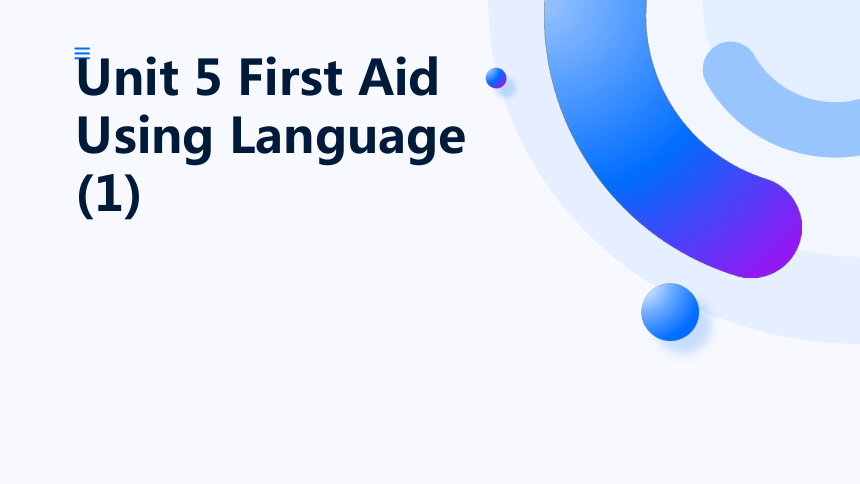 | |
| 格式 | pptx | ||
| 文件大小 | 8.3MB | ||
| 资源类型 | 教案 | ||
| 版本资源 | 人教版(2019) | ||
| 科目 | 英语 | ||
| 更新时间 | 2025-03-05 10:00:46 | ||
图片预览

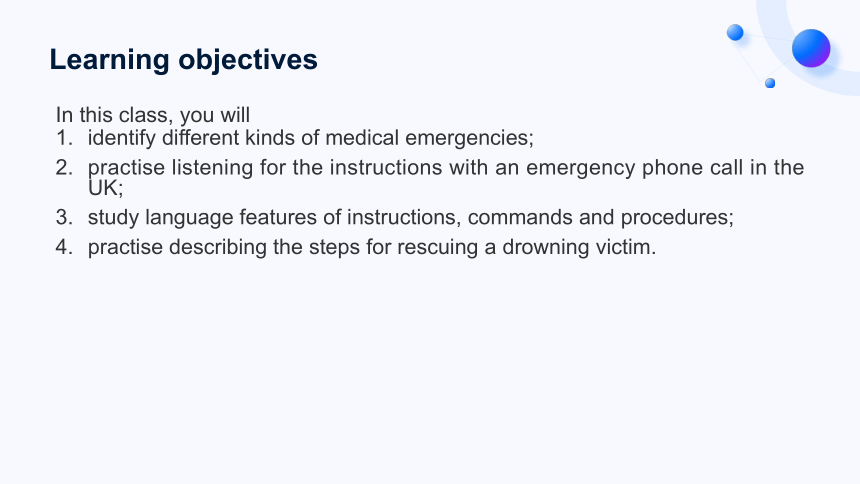
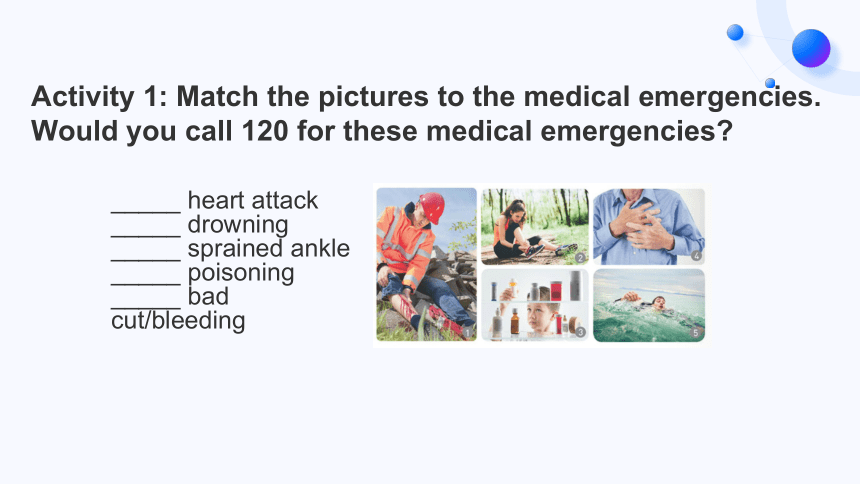
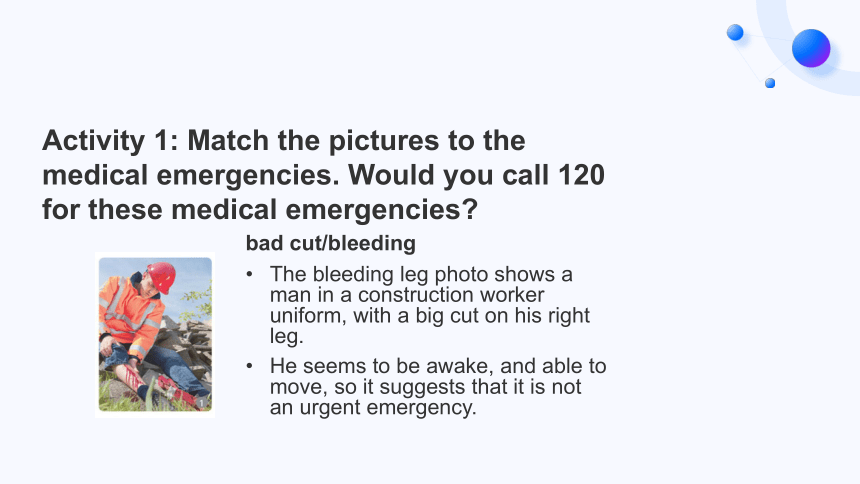
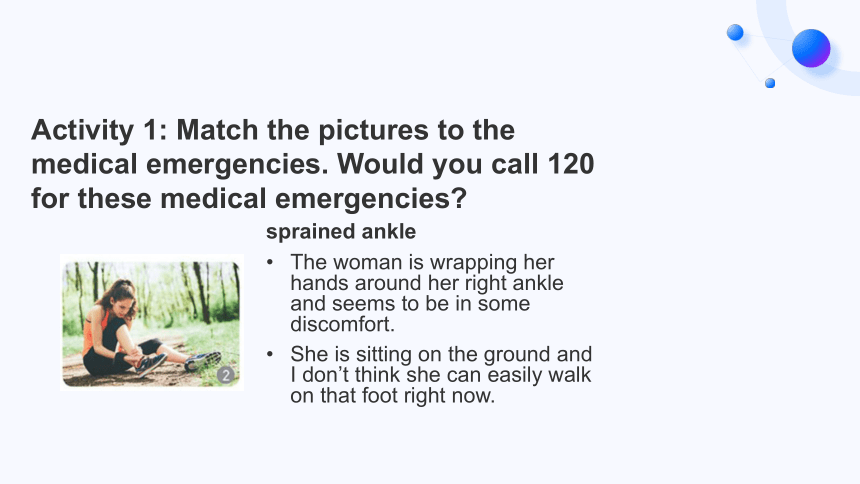
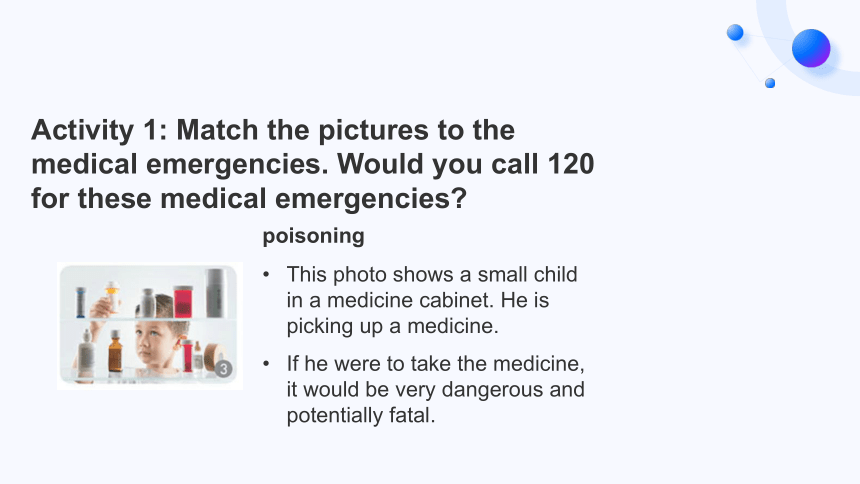
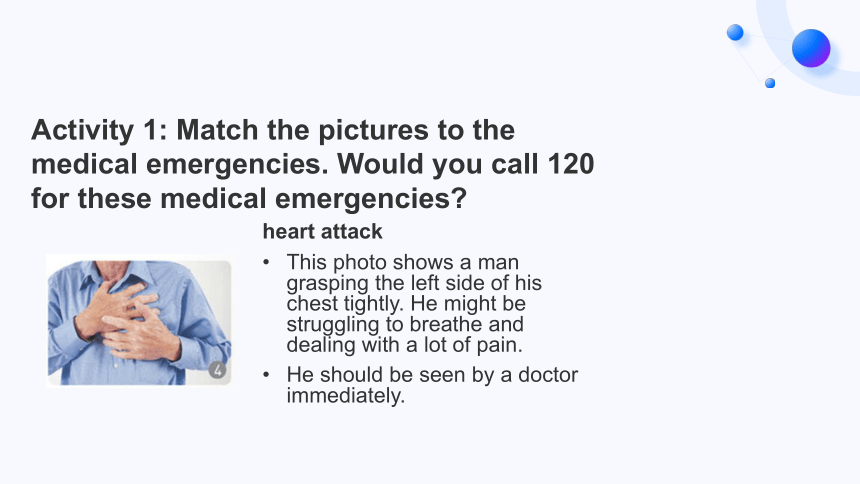
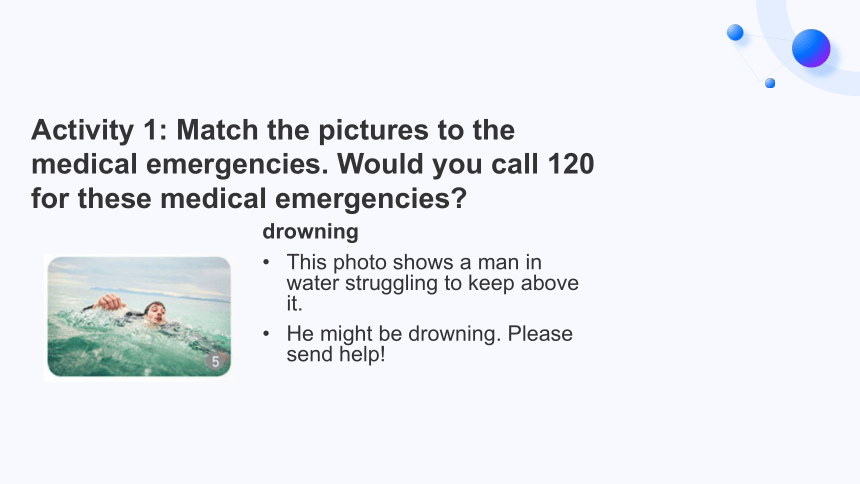
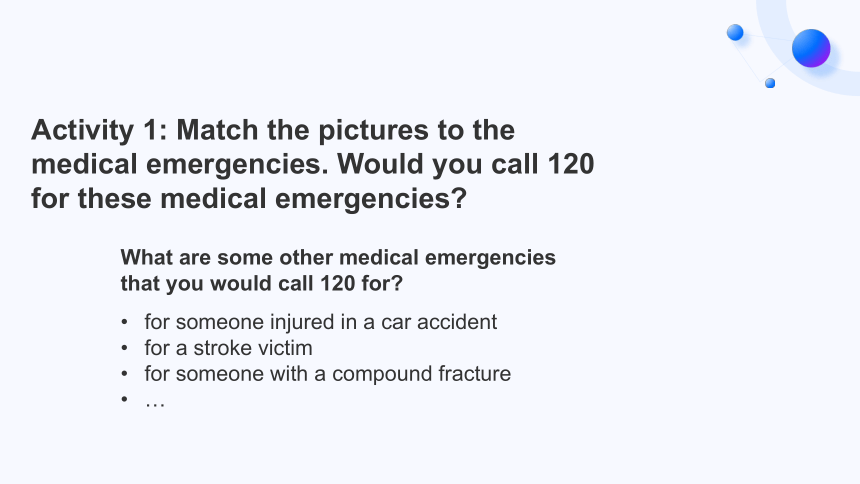
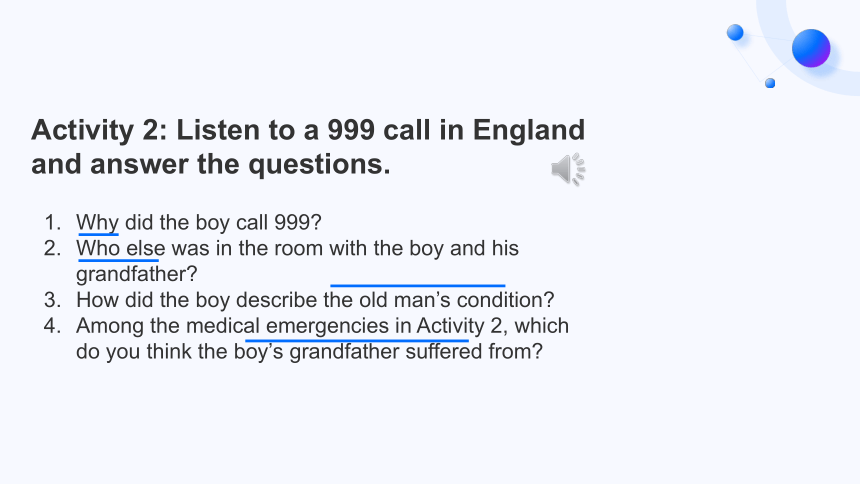
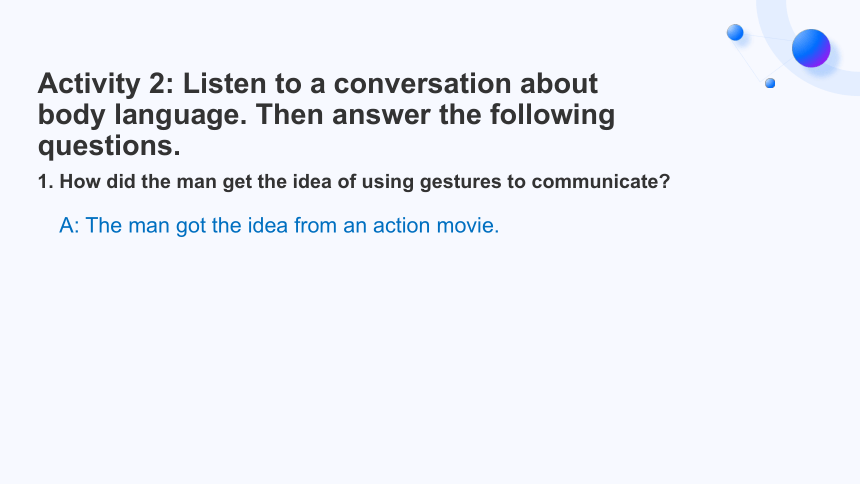
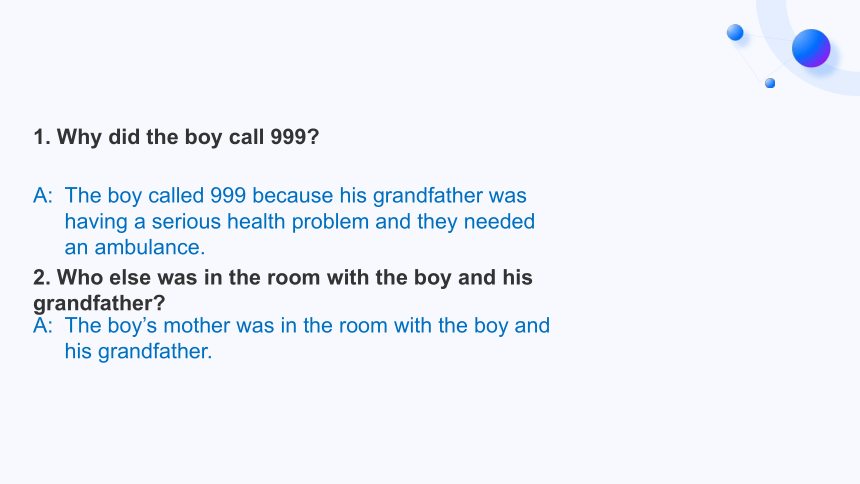
文档简介
(共34张PPT)
Unit 5 First Aid
Using Language (1)
Learning objectives
In this class, you will
identify different kinds of medical emergencies;
practise listening for the instructions with an emergency phone call in the UK;
study language features of instructions, commands and procedures;
practise describing the steps for rescuing a drowning victim.
Activity 1: Match the pictures to the medical emergencies. Would you call 120 for these medical emergencies
_____ heart attack
_____ drowning
_____ sprained ankle
_____ poisoning
_____ bad cut/bleeding
Activity 1: Match the pictures to the medical emergencies. Would you call 120 for these medical emergencies
bad cut/bleeding
The bleeding leg photo shows a man in a construction worker uniform, with a big cut on his right leg.
He seems to be awake, and able to move, so it suggests that it is not an urgent emergency.
Activity 1: Match the pictures to the medical emergencies. Would you call 120 for these medical emergencies
sprained ankle
The woman is wrapping her hands around her right ankle and seems to be in some discomfort.
She is sitting on the ground and I don’t think she can easily walk on that foot right now.
Activity 1: Match the pictures to the medical emergencies. Would you call 120 for these medical emergencies
poisoning
This photo shows a small child in a medicine cabinet. He is picking up a medicine.
If he were to take the medicine, it would be very dangerous and potentially fatal.
Activity 1: Match the pictures to the medical emergencies. Would you call 120 for these medical emergencies
heart attack
This photo shows a man grasping the left side of his chest tightly. He might be struggling to breathe and dealing with a lot of pain.
He should be seen by a doctor immediately.
Activity 1: Match the pictures to the medical emergencies. Would you call 120 for these medical emergencies
drowning
This photo shows a man in water struggling to keep above it.
He might be drowning. Please send help!
Activity 1: Match the pictures to the medical emergencies. Would you call 120 for these medical emergencies
What are some other medical emergencies that you would call 120 for
for someone injured in a car accident
for a stroke victim
for someone with a compound fracture
…
Activity 2: Listen to a 999 call in England and answer the questions.
Why did the boy call 999
Who else was in the room with the boy and his grandfather
How did the boy describe the old man’s condition
Among the medical emergencies in Activity 2, which do you think the boy’s grandfather suffered from
Activity 2: Listen to a conversation about body language. Then answer the following questions.
1. How did the man get the idea of using gestures to communicate
A: The man got the idea from an action movie.
1. Why did the boy call 999
A: The boy called 999 because his grandfather was having a serious health problem and they needed an ambulance.
2. Who else was in the room with the boy and his grandfather
A: The boy’s mother was in the room with the boy and his grandfather.
3. How did the boy describe the old man’s condition
A: “… his breathing has gotten really bad ... I think he’s dying … His face looks funny … he’s started to breathe again … his lips are blue … He’s making strange noises … He’s not breathing again … he’s not breathing anymore!”
4. Among the medical emergencies in Activity 2, which do you think the boy’s grandfather suffered from
A: Perhaps he suffered from a heart attack.
Activity 2: Listen to a 999 call in England and answer the questions.
What did the operator do to make this call a success
She told the boy to calm down and calmly asked him questions. Also, she asked only the questions necessary to clearly find out the problem, and then she provided short and clear instructions as to what to do.
When giving commands, people usually use the imperative.
When giving instructions, people use first, next, then… to indicate order.
Activity 3: Listen again. Number the following instructions the operator gave.
__________ __________ __________ __________ __________ __________ Press down, twice a second.
Check to see if there is food in his mouth.
If your mother needs a break, change places.
Put him on his back.
Remove any pillows.
Tell your mum to put her hand in the middle of his chest.
Activity 3: Listen again. Number the following instructions the operator gave.
____ _____ ____ _____ ____ _____ ____ _____ ____ _____ ____ _____ Press down, twice a second.
Check to see if there is food in his mouth.
If your mother needs a break, change places.
Put him on his back.
Remove any pillows.
Tell your mum to put her hand in the middle of his chest.
Activity 4: Listen again. Learn the language used to make emergency calls.
Please write down the questions the operator asked.
Could you tell me your address
And your phone number
Now calm down and tell me what’s wrong.
How old is he
Activity 4: Listen again. Learn the language used to make emergency calls.
Please write down the questions the operator asked.
Are you with him now
Is he on his back
Any food there
So, he’s breathing
Is he conscious now
Activity 4: Listen again. Learn the language used to make emergency calls.
More language support:
What’s your emergency / What emergency are you reporting / What service do you need, ambulance, police, or fire brigade
What’s your location / Where are you exactly What’s the address of the emergency
Is the victim a male or female
Activity 4: Listen again. Learn the language used to make emergency calls.
More language support:
What’s your emergency / What emergency are you reporting / What service do you need, ambulance, police, or fire brigade
What’s your location / Where are you exactly What’s the address of the emergency
Is the victim a male or female
Activity 5: The pictures below show what to do to rescue someone from drowning. Talk about what is going on in each picture.
Activity 5: The pictures below show what to do to rescue someone from drowning. Talk about what is going on in each picture.
Lay the victim on his back.
Activity 5: The pictures below show what to do to rescue someone from drowning. Talk about what is going on in each picture.
Check for a response by patting his shoulders and calling him near each side of his ears.
Activity 5: The pictures below show what to do to rescue someone from drowning. Talk about what is going on in each picture.
Shout for help and/or call 120.
Activity 5: The pictures below show what to do to rescue someone from drowning. Talk about what is going on in each picture.
Lift his chin.
Begin doing mouth-to-mouth rescue breathing: Blow air in his mouth until his chest rises.
Activity 5: The pictures below show what to do to rescue someone from drowning. Talk about what is going on in each picture.
Perform CPR by pushing down on the centre of his chest, and then giving him mouth-to-mouth rescue breathing. Continue pushing on his chest and giving him mouth-to-mouth rescue breathing until help arrives.
Activity 5: The pictures below show what to do to rescue someone from drowning. Talk about what is going on in each picture.
In more detail, for a drowning victim, you should:
Activity 5: The pictures below show what to do to rescue someone from drowning. Talk about what is going on in each picture.
Firstly, you should lay the victim on his back. Next, you can turn his head to the side to drain out any water. Remove any grass or sand from his mouth. After that, check to see if he is breathing by putting your ear between his mouth and nose, and seeing if you can feel his breath, while looking to see if his chest is moving.
Activity 5: The pictures below show what to do to rescue someone from drowning. Talk about what is going on in each picture.
If he is not breathing, check for a pulse. If no pulse or no breathing, call 120 or shout for help. If there is a pulse but no breathing, then move the victim’s head back and begin doing mouth-to-mouth rescue breathing: Tilt the person’s head back and blow air in until his chest rises. Do this every five seconds.
Activity 5: The pictures below show what to do to rescue someone from drowning. Talk about what is going on in each picture.
Finally, if there is no pulse and no breathing, then push down on the chest at least 100 times per minute. Every thirty pushes, give him two deep breaths, and continue pushing on his chest and giving him mouth-to-mouth rescue breathing until help arrives.
Activity 5: The pictures below show what to do to rescue someone from drowning. Talk about what is going on in each picture.
Homework
Review situations requiring first aid in Activity 2. Choose one emergency and collect its first-aid measures. Create your own dialogue and you can refer to the listening text in our class.
Unit 5 First Aid
Using Language (1)
Learning objectives
In this class, you will
identify different kinds of medical emergencies;
practise listening for the instructions with an emergency phone call in the UK;
study language features of instructions, commands and procedures;
practise describing the steps for rescuing a drowning victim.
Activity 1: Match the pictures to the medical emergencies. Would you call 120 for these medical emergencies
_____ heart attack
_____ drowning
_____ sprained ankle
_____ poisoning
_____ bad cut/bleeding
Activity 1: Match the pictures to the medical emergencies. Would you call 120 for these medical emergencies
bad cut/bleeding
The bleeding leg photo shows a man in a construction worker uniform, with a big cut on his right leg.
He seems to be awake, and able to move, so it suggests that it is not an urgent emergency.
Activity 1: Match the pictures to the medical emergencies. Would you call 120 for these medical emergencies
sprained ankle
The woman is wrapping her hands around her right ankle and seems to be in some discomfort.
She is sitting on the ground and I don’t think she can easily walk on that foot right now.
Activity 1: Match the pictures to the medical emergencies. Would you call 120 for these medical emergencies
poisoning
This photo shows a small child in a medicine cabinet. He is picking up a medicine.
If he were to take the medicine, it would be very dangerous and potentially fatal.
Activity 1: Match the pictures to the medical emergencies. Would you call 120 for these medical emergencies
heart attack
This photo shows a man grasping the left side of his chest tightly. He might be struggling to breathe and dealing with a lot of pain.
He should be seen by a doctor immediately.
Activity 1: Match the pictures to the medical emergencies. Would you call 120 for these medical emergencies
drowning
This photo shows a man in water struggling to keep above it.
He might be drowning. Please send help!
Activity 1: Match the pictures to the medical emergencies. Would you call 120 for these medical emergencies
What are some other medical emergencies that you would call 120 for
for someone injured in a car accident
for a stroke victim
for someone with a compound fracture
…
Activity 2: Listen to a 999 call in England and answer the questions.
Why did the boy call 999
Who else was in the room with the boy and his grandfather
How did the boy describe the old man’s condition
Among the medical emergencies in Activity 2, which do you think the boy’s grandfather suffered from
Activity 2: Listen to a conversation about body language. Then answer the following questions.
1. How did the man get the idea of using gestures to communicate
A: The man got the idea from an action movie.
1. Why did the boy call 999
A: The boy called 999 because his grandfather was having a serious health problem and they needed an ambulance.
2. Who else was in the room with the boy and his grandfather
A: The boy’s mother was in the room with the boy and his grandfather.
3. How did the boy describe the old man’s condition
A: “… his breathing has gotten really bad ... I think he’s dying … His face looks funny … he’s started to breathe again … his lips are blue … He’s making strange noises … He’s not breathing again … he’s not breathing anymore!”
4. Among the medical emergencies in Activity 2, which do you think the boy’s grandfather suffered from
A: Perhaps he suffered from a heart attack.
Activity 2: Listen to a 999 call in England and answer the questions.
What did the operator do to make this call a success
She told the boy to calm down and calmly asked him questions. Also, she asked only the questions necessary to clearly find out the problem, and then she provided short and clear instructions as to what to do.
When giving commands, people usually use the imperative.
When giving instructions, people use first, next, then… to indicate order.
Activity 3: Listen again. Number the following instructions the operator gave.
__________ __________ __________ __________ __________ __________ Press down, twice a second.
Check to see if there is food in his mouth.
If your mother needs a break, change places.
Put him on his back.
Remove any pillows.
Tell your mum to put her hand in the middle of his chest.
Activity 3: Listen again. Number the following instructions the operator gave.
____ _____ ____ _____ ____ _____ ____ _____ ____ _____ ____ _____ Press down, twice a second.
Check to see if there is food in his mouth.
If your mother needs a break, change places.
Put him on his back.
Remove any pillows.
Tell your mum to put her hand in the middle of his chest.
Activity 4: Listen again. Learn the language used to make emergency calls.
Please write down the questions the operator asked.
Could you tell me your address
And your phone number
Now calm down and tell me what’s wrong.
How old is he
Activity 4: Listen again. Learn the language used to make emergency calls.
Please write down the questions the operator asked.
Are you with him now
Is he on his back
Any food there
So, he’s breathing
Is he conscious now
Activity 4: Listen again. Learn the language used to make emergency calls.
More language support:
What’s your emergency / What emergency are you reporting / What service do you need, ambulance, police, or fire brigade
What’s your location / Where are you exactly What’s the address of the emergency
Is the victim a male or female
Activity 4: Listen again. Learn the language used to make emergency calls.
More language support:
What’s your emergency / What emergency are you reporting / What service do you need, ambulance, police, or fire brigade
What’s your location / Where are you exactly What’s the address of the emergency
Is the victim a male or female
Activity 5: The pictures below show what to do to rescue someone from drowning. Talk about what is going on in each picture.
Activity 5: The pictures below show what to do to rescue someone from drowning. Talk about what is going on in each picture.
Lay the victim on his back.
Activity 5: The pictures below show what to do to rescue someone from drowning. Talk about what is going on in each picture.
Check for a response by patting his shoulders and calling him near each side of his ears.
Activity 5: The pictures below show what to do to rescue someone from drowning. Talk about what is going on in each picture.
Shout for help and/or call 120.
Activity 5: The pictures below show what to do to rescue someone from drowning. Talk about what is going on in each picture.
Lift his chin.
Begin doing mouth-to-mouth rescue breathing: Blow air in his mouth until his chest rises.
Activity 5: The pictures below show what to do to rescue someone from drowning. Talk about what is going on in each picture.
Perform CPR by pushing down on the centre of his chest, and then giving him mouth-to-mouth rescue breathing. Continue pushing on his chest and giving him mouth-to-mouth rescue breathing until help arrives.
Activity 5: The pictures below show what to do to rescue someone from drowning. Talk about what is going on in each picture.
In more detail, for a drowning victim, you should:
Activity 5: The pictures below show what to do to rescue someone from drowning. Talk about what is going on in each picture.
Firstly, you should lay the victim on his back. Next, you can turn his head to the side to drain out any water. Remove any grass or sand from his mouth. After that, check to see if he is breathing by putting your ear between his mouth and nose, and seeing if you can feel his breath, while looking to see if his chest is moving.
Activity 5: The pictures below show what to do to rescue someone from drowning. Talk about what is going on in each picture.
If he is not breathing, check for a pulse. If no pulse or no breathing, call 120 or shout for help. If there is a pulse but no breathing, then move the victim’s head back and begin doing mouth-to-mouth rescue breathing: Tilt the person’s head back and blow air in until his chest rises. Do this every five seconds.
Activity 5: The pictures below show what to do to rescue someone from drowning. Talk about what is going on in each picture.
Finally, if there is no pulse and no breathing, then push down on the chest at least 100 times per minute. Every thirty pushes, give him two deep breaths, and continue pushing on his chest and giving him mouth-to-mouth rescue breathing until help arrives.
Activity 5: The pictures below show what to do to rescue someone from drowning. Talk about what is going on in each picture.
Homework
Review situations requiring first aid in Activity 2. Choose one emergency and collect its first-aid measures. Create your own dialogue and you can refer to the listening text in our class.
